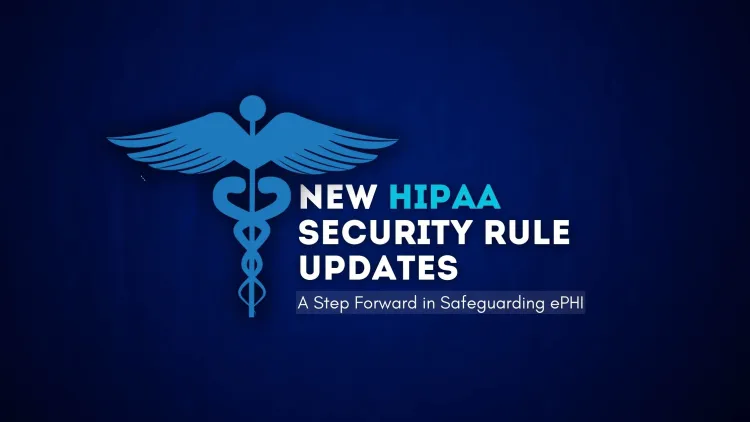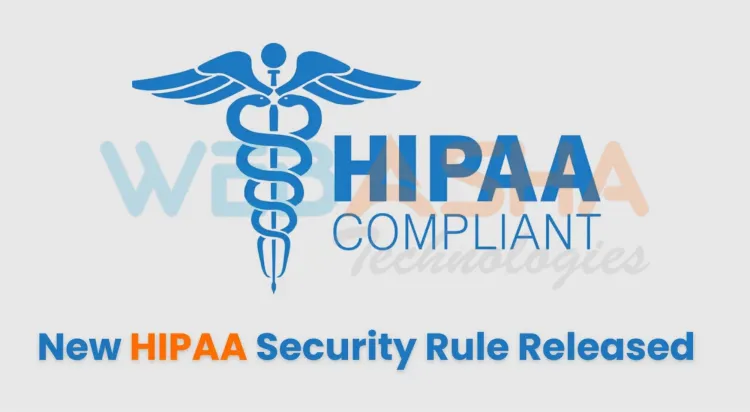New HIPAA Security Rule Updates | A Step Forward in Safeguarding ePHI
The U.S. Department of Health and Human Services (HHS) has proposed updates to the HIPAA Security Rule to address rising cybersecurity threats in healthcare. The updates aim to modernize data protection practices, streamline compliance, and enhance safeguards for electronic protected health information (ePHI). Key changes include mandatory encryption, comprehensive risk analysis, annual compliance audits, and the introduction of stronger technical controls like multi-factor authentication and vulnerability scans. These measures will strengthen defenses, ensure faster incident response, and protect patient data. Stakeholders are encouraged to provide feedback during the 60-day comment period to help shape these crucial regulatory improvements.

The U.S. Department of Health and Human Services (HHS), through its Office for Civil Rights (OCR), has proposed significant updates to the HIPAA Security Rule to improve the protection of electronic protected health information (ePHI). This Notice of Proposed Rulemaking (NPRM) reflects the growing need for stronger cybersecurity measures in the healthcare industry.

Overview of the HIPAA Security Rule
The HIPAA Security Rule, first introduced in 1996, establishes national standards to secure ePHI. It applies to covered entities such as:
- Health plans
- Healthcare clearinghouses
- Most healthcare providers
- Business associates
The proposed revisions align with federal initiatives like the National Cybersecurity Strategy and the Healthcare Sector Cybersecurity Concept Paper to bolster cybersecurity in healthcare.
Key Proposed Updates to the HIPAA Security Rule
The proposed changes aim to modernize the Security Rule by eliminating outdated provisions and introducing enhanced safeguards. Below are the major updates:
1. Streamlined and Standardized Requirements
- Removal of the distinction between “required” and “addressable” implementation specifications.
- Mandatory documentation of all Security Rule policies, procedures, and analyses in writing.
2. Enhanced Risk Management and Compliance Measures
- Introduction of explicit compliance deadlines.
- Mandatory technology asset inventory and network map tracking ePHI, updated annually or after major changes.
- Comprehensive risk analysis requiring written assessments of potential threats and vulnerabilities.
3. Stronger Incident Response Protocols
- Notifications to workforce members within 24 hours of access changes to ePHI.
- Written contingency plans to restore lost systems and data within 72 hours.
- Regular testing of security incident response plans.
4. Technical Safeguards for ePHI
- Encryption of ePHI both at rest and in transit.
- Implementation of:
- Multi-factor authentication
- Vulnerability scanning every six months
- Annual penetration testing
- Network segmentation to limit threat impact
- Use of security-enhancing tools like anti-malware software and disabling unused network ports.
5. Audits and Accountability
- Annual compliance audits.
- Written certifications from business associates and subcontractors confirming their technical safeguards.
- Updated plan documents for group health plans to ensure safeguard compliance.
6. Additional Requirements
- Separate technical controls for backup and recovery systems.
- Annual cybersecurity effectiveness tests.
- 24-hour notification to covered entities upon activating contingency plans.
Why These Changes Are Important
Cyberattacks in healthcare are becoming more sophisticated, posing a threat to patient data and organizational operations. These updates aim to:
- Strengthen the industry’s defenses against cyber threats.
- Ensure quicker incident response.
- Protect patient privacy and maintain trust.
Public Input and Next Steps
The NPRM encourages feedback from various stakeholders, including:
- Healthcare providers
- Health plans
- Patients
- Professional associations
- Consumer advocates
Comments can be submitted through regulations.gov during the 60-day public comment period. Additionally, HHS plans to hold a Tribal consultation meeting to gather input from Tribal communities.
Conclusion
The proposed updates to the HIPAA Security Rule mark a critical step toward improving cybersecurity in the healthcare sector. By adopting these changes, organizations can better protect sensitive patient information, respond to threats more effectively, and build resilience against cyberattacks. Stakeholders are encouraged to review the NPRM and provide their input to shape a safer and more secure healthcare system.
FAQs
-
What is the HIPAA Security Rule?
The HIPAA Security Rule establishes national standards to protect electronic protected health information (ePHI) and applies to health plans, healthcare providers, and business associates. -
Why are updates to the HIPAA Security Rule being proposed?
The updates aim to address growing cybersecurity threats in the healthcare industry and improve data protection and incident response measures. -
What is a Notice of Proposed Rulemaking (NPRM)?
NPRM is a formal process where proposed changes to regulations are announced, allowing the public to provide feedback before implementation. -
Who is affected by the proposed updates?
Covered entities such as health plans, healthcare providers, business associates, and their subcontractors. -
What are some key updates to the Security Rule?
- Mandatory encryption of ePHI.
- Annual compliance audits.
- Enhanced risk analysis and contingency planning.
- Multi-factor authentication and regular vulnerability scans.
-
What are technical safeguards for ePHI?
Measures like encryption, network segmentation, multi-factor authentication, and anti-malware software to secure sensitive health information. -
What is the significance of risk analysis under the proposed updates?
Organizations must conduct comprehensive risk assessments, identifying vulnerabilities and their likelihood of exploitation, to enhance security. -
What is the timeline for implementing these updates?
If approved, the updates will have specific deadlines, such as annual audits and regular testing of contingency plans. -
How can stakeholders provide feedback on the proposed changes?
Feedback can be submitted through regulations.gov during the 60-day public comment period. -
Why is this update crucial for the healthcare industry?
It strengthens defenses against increasing cyber threats, ensures faster responses to incidents, and protects patient data.











![Top 10 Ethical Hackers in the World [2025]](https://www.webasha.com/blog/uploads/images/202408/image_100x75_66c2f983c207b.webp)



![[2025] Top 100+ VAPT Interview Questions and Answers](https://www.webasha.com/blog/uploads/images/image_100x75_6512b1e4b64f7.jpg)







